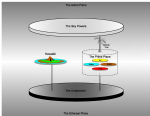CleverNickName
Limit Break Dancing
Here is the cosmology I wrote for my old "Gods of the Fire Islands" PDF, back in the day. I'm not sure if it's still available for download on ENWorld; I haven't checked in quite some time.
-----
Cosmology of the Fire Islands

In the beginning, there was only the Ethereal plane (Papa) and the Astral plane (Rangi). When the two were forced apart, light and matter (the Prime Plane) began to coexist between them. Thus, the universe according to the Fire Island traditions is organized with the Prime Plane wedged tightly between the Astral and Ethereal planes.
The Material Plane, or “Papa,” is organized by its four distinct layers of elements, in three layers. Earth and Water are side-by-side in the middle, with Fire below and Earth above (see figure). The elemental demi-planes (not shown), such as Dust, Rain, Mud, Steam, and Magma, form on the boundaries of these planes, and are evident in the material plane wherever two or more planes overlap (i.e., Magma lies on the boundary of Earth and Fire, and Rain lies on the boundary between Water and Air.)
The Plane of Shadow, the Infinite Layers of the Abyss, the Negative Energy Plane, and the Nine Hells are all demi-planes within the Ethereal Plane, and are collectively referred to as “The Underworld.” Buried beneath the world, these demi-planes are not visible from the Prime Plane.
Likewise, the Positive Energy Plane, The Celestial Realms, the Twelve High Heavens, and The Void are demi-planes within the Astral Plane, and are collectively referred to as “Rangi,” or The Sky Powers. They appear in the Prime Plane as the sun (Heaven), the moon (Positive Energy Plane), and stars (The Celestial Realms) moving across the sky (The Void).
Hawaiki is the land of mankind’s ancestors, the birthplace of Tiki and the place where his children's souls live forever in peace. It lies adjacent to the Material Plane, but is accessible only by traveling through the Underworld. When a person dies, their soul is sent to the Underworld for judgment, and those who are found worthy are carried to the Ancestor Island in a canoe rowed by beautiful women. Those who are found wanting are forced to remain in the Underworld forever.
-----
Cosmology of the Fire Islands

In the beginning, there was only the Ethereal plane (Papa) and the Astral plane (Rangi). When the two were forced apart, light and matter (the Prime Plane) began to coexist between them. Thus, the universe according to the Fire Island traditions is organized with the Prime Plane wedged tightly between the Astral and Ethereal planes.
The Material Plane, or “Papa,” is organized by its four distinct layers of elements, in three layers. Earth and Water are side-by-side in the middle, with Fire below and Earth above (see figure). The elemental demi-planes (not shown), such as Dust, Rain, Mud, Steam, and Magma, form on the boundaries of these planes, and are evident in the material plane wherever two or more planes overlap (i.e., Magma lies on the boundary of Earth and Fire, and Rain lies on the boundary between Water and Air.)
The Plane of Shadow, the Infinite Layers of the Abyss, the Negative Energy Plane, and the Nine Hells are all demi-planes within the Ethereal Plane, and are collectively referred to as “The Underworld.” Buried beneath the world, these demi-planes are not visible from the Prime Plane.
Likewise, the Positive Energy Plane, The Celestial Realms, the Twelve High Heavens, and The Void are demi-planes within the Astral Plane, and are collectively referred to as “Rangi,” or The Sky Powers. They appear in the Prime Plane as the sun (Heaven), the moon (Positive Energy Plane), and stars (The Celestial Realms) moving across the sky (The Void).
Hawaiki is the land of mankind’s ancestors, the birthplace of Tiki and the place where his children's souls live forever in peace. It lies adjacent to the Material Plane, but is accessible only by traveling through the Underworld. When a person dies, their soul is sent to the Underworld for judgment, and those who are found worthy are carried to the Ancestor Island in a canoe rowed by beautiful women. Those who are found wanting are forced to remain in the Underworld forever.
